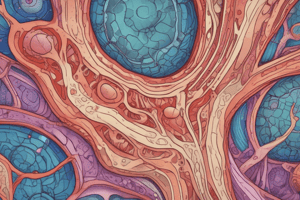Podcast
Questions and Answers
A patient has a skin disorder that impairs the function of dendritic cells. Which of the following functions of the epidermis would be most affected?
A patient has a skin disorder that impairs the function of dendritic cells. Which of the following functions of the epidermis would be most affected?
- The skin's ability to provide a barrier against water loss.
- The skin's ability to detect fine touch and pressure.
- The skin's ability to initiate an immune response against pathogens. (correct)
- The skin's ability to produce melanin and protect against UV radiation.
If a medication inhibits mitosis in the stratum basale, which of the following would be the most likely side effect?
If a medication inhibits mitosis in the stratum basale, which of the following would be the most likely side effect?
- Reduced tactile sensation.
- Increased melanin production.
- Slower wound healing of the epidermis. (correct)
- Impaired immune response in the skin.
A forensic scientist is examining a skin sample. The presence of a stratum lucidum layer suggests that the sample is most likely from which part of the body?
A forensic scientist is examining a skin sample. The presence of a stratum lucidum layer suggests that the sample is most likely from which part of the body?
- Scalp
- Back
- Abdomen
- Palm of the hand (correct)
What would be the primary consequence if melanocytes were no longer able to produce melanin?
What would be the primary consequence if melanocytes were no longer able to produce melanin?
In a skin biopsy, a pathologist identifies an increased number of macrophages. This most likely indicates which condition?
In a skin biopsy, a pathologist identifies an increased number of macrophages. This most likely indicates which condition?
Flashcards
Epidermis
Epidermis
The outer layer of skin, made of keratinized stratified squamous epithelium.
Stratum Corneum
Stratum Corneum
The outermost layer of the epidermis, replaced every 4 weeks.
Keratinocytes
Keratinocytes
Cells that produce keratin and are found in all layers of the epidermis.
Melanocytes
Melanocytes
Signup and view all the flashcards
Continuous Turnover
Continuous Turnover
Signup and view all the flashcards
Study Notes
Epidermis Structure
- Keratinized stratified squamous epithelium
- 5 layers in thick skin (hands and feet), 4 in thin skin (elsewhere)
- Layers (superficial to deep):
- Stratum corneum: replaced every 4 weeks
- Stratum lucidum: only in thick skin
- Stratum granulosum
- Stratum spinosum
- Stratum basale: connects to dermis, high mitotic activity, source of stem cells for keratinocytes.
Cell Types in the Epidermis
- Keratinocytes: Abundant, located in all layers, produce keratin.
- Melanocytes: Located in stratum basale, produce melanin
- Tactile (Merkel) Cells: In stratum basale, sense touch (abundant on hands and feet)
- Dendritic (Langerhans) Cells: Located in stratum spinosum and stratum granulosum, part of immune system, engulf/destroy pathogens
- Macrophages: Part of immune system; engulf bacteria, foreign particles, and damaged cells (WBCs)
Epidermal Renewal
- Continuously replaced by cells originating from stem cells in the stratum basale.
Studying That Suits You
Use AI to generate personalized quizzes and flashcards to suit your learning preferences.




